
Hydroxyquinoline
CAS No. 148-24-3
Hydroxyquinoline( Oxyquinoline | NSC 2039 | NSC-2039 | NSC2039 )
Catalog No. M12044 CAS No. 148-24-3
8-Hydroxyquinoline is a monoprotic bidentate chelating agent, exhibits antiseptic, disinfectant, and pesticide properties.
Purity : >98% (HPLC)
 COA
COA
 Datasheet
Datasheet
 HNMR
HNMR
 HPLC
HPLC
 MSDS
MSDS
 Handing Instructions
Handing Instructions
| Size | Price / USD | Stock | Quantity |
| 50MG | 41 | In Stock |


|
| 100MG | 58 | In Stock |


|
| 200MG | 87 | In Stock |


|
| 500MG | Get Quote | In Stock |


|
| 1G | Get Quote | In Stock |


|
Biological Information
-
Product NameHydroxyquinoline
-
NoteResearch use only, not for human use.
-
Brief Description8-Hydroxyquinoline is a monoprotic bidentate chelating agent, exhibits antiseptic, disinfectant, and pesticide properties.
-
Description8-Hydroxyquinoline is a monoprotic bidentate chelating agent, exhibits antiseptic, disinfectant, and pesticide properties, functioning as a transcription inhibitor.
-
In VitroCell Viability Assay Cell Line:DCIS cells Concentration:1,2.5,5,10,20 μM Incubation Time:1 or 8 hour Result:Binding to copper and form complexes make the cells rounded up and detached, induces cell death with in a concentration- and time-dependent manner. 8-OHQ- and CQ-Cu, but not mixture of their analogues and Cu, could induce cancer cell death in a concentration- and time-dependent manner. Western Blot Analysis Cell Line:DCIS cellsConcentration:1,2.5,5 μM.Incubation Time:0,2,4,8,12 hours Result:Mixture of CuCl2 inhibited the CT-like activity in a concentration- and time-dependent manner. Mixture of CuCl2 decreased proteasomal activity and increased ubquititinated proteins and Bax accumulated in a time-dependent manner. RT-PCR Cell Line:Lipopolysaccharides (HY-D1056)-stimulated Raw 264.7 cells Concentration:25,50,75,100 μM Incubation Time:30 min Result:Inhibited of LPS-induced NO and iNOS expression.Inhibits transcription of iNOS. Had not affect phosphorylation of MAPKs. Inhibited NF-jB-binding activity and C/EBPb-binding activity.
-
In VivoAnimal Model:CD1 mice Dosage:25,50,100 mg/kg Administration:Intraperitoneal injection (i.p.)Result:Resulted in a significant dose-related increase in the number of micronucleated polychromatic erythrocytes (MPCE) at the 24 h samplingtime for all doses tested. Animal Model:C57BL miceDosage:0.3% 4 times weekly.Administration:Skin administration Result:Caused depigmented hair to grow in patterns which change with time. Sufficiently frequent applications result in virtually complete depigmentation in young adult C57BL female mice, while single application causes isolated bands of depigmented hair.
-
SynonymsOxyquinoline | NSC 2039 | NSC-2039 | NSC2039
-
PathwayOthers
-
TargetOther Targets
-
RecptorOthers
-
Research AreaOther Indications
-
Indication——
Chemical Information
-
CAS Number148-24-3
-
Formula Weight145.16
-
Molecular FormulaC9H7NO
-
Purity>98% (HPLC)
-
SolubilityWater: 556 mg/l at 20 °C
-
SMILESOC1=C2N=CC=CC2=CC=C1
-
Chemical Name8-Hydroxyquinoline
Shipping & Storage Information
-
Storage(-20℃)
-
ShippingWith Ice Pack
-
Stability≥ 2 years
Reference
1.Freitas LB, et al. Eur J Med Chem. 2014 Sep 12;84:595-604.
molnova catalog



related products
-
ICI-118551 Hydrochlo...
ICI-118551 is a highly selective β2-adrenergic receptor antagonist with Ki values of 0.7, 49.5 and 611 nM for β2, β1 and β3 receptors, respectively.
-
Rhodamine 123
Rhodamine 123 is a fluorescent dye (λex=503 nm, λem=527 nm). The intensity of R123 fluorescence has a peak at concentration of 50 μM, and decreases to zero at higher concentrations due to self-quenching.
-
2-Deoxy-D-glucose
2-Deoxy-D-glucose, an analog of glucose, is a glycolytic inhibitor with antiviral activity.



 Cart
Cart
 sales@molnova.com
sales@molnova.com


